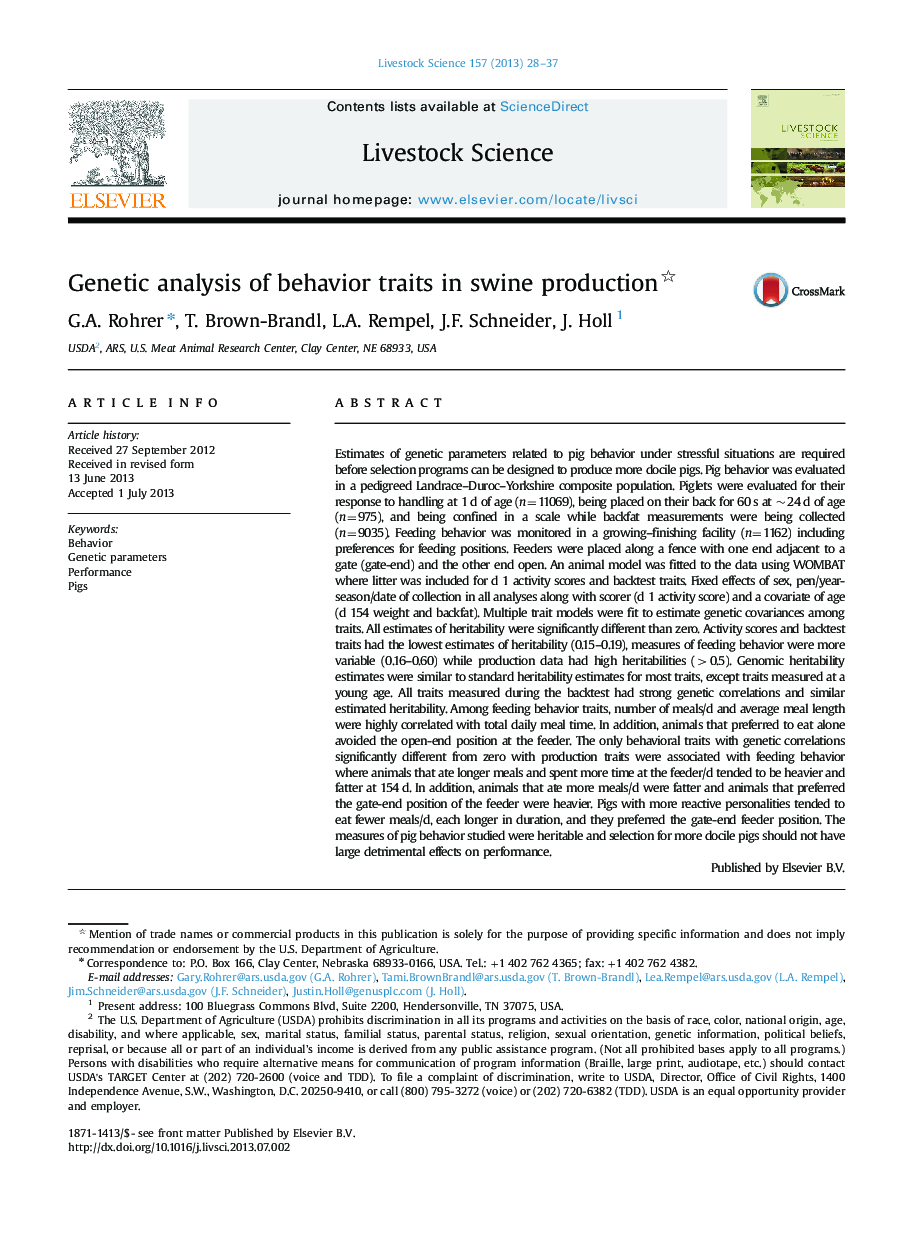| کد مقاله | کد نشریه | سال انتشار | مقاله انگلیسی | نسخه تمام متن |
|---|---|---|---|---|
| 5790344 | 1109492 | 2013 | 10 صفحه PDF | دانلود رایگان |
عنوان انگلیسی مقاله ISI
Genetic analysis of behavior traits in swine production
ترجمه فارسی عنوان
تجزیه و تحلیل ژنتیکی صفات رفتار در تولید خوک
دانلود مقاله + سفارش ترجمه
دانلود مقاله ISI انگلیسی
رایگان برای ایرانیان
کلمات کلیدی
رفتار - اخلاق، پارامترهای ژنتیکی، کارایی، خوک ها،
موضوعات مرتبط
علوم زیستی و بیوفناوری
علوم کشاورزی و بیولوژیک
علوم دامی و جانورشناسی
چکیده انگلیسی
Estimates of genetic parameters related to pig behavior under stressful situations are required before selection programs can be designed to produce more docile pigs. Pig behavior was evaluated in a pedigreed Landrace-Duroc-Yorkshire composite population. Piglets were evaluated for their response to handling at 1Â d of age (n=11069), being placed on their back for 60Â s at ~24Â d of age (n=975), and being confined in a scale while backfat measurements were being collected (n=9035). Feeding behavior was monitored in a growing-finishing facility (n=1162) including preferences for feeding positions. Feeders were placed along a fence with one end adjacent to a gate (gate-end) and the other end open. An animal model was fitted to the data using WOMBAT where litter was included for d 1 activity scores and backtest traits. Fixed effects of sex, pen/year-season/date of collection in all analyses along with scorer (d 1 activity score) and a covariate of age (d 154 weight and backfat). Multiple trait models were fit to estimate genetic covariances among traits. All estimates of heritability were significantly different than zero. Activity scores and backtest traits had the lowest estimates of heritability (0.15-0.19), measures of feeding behavior were more variable (0.16-0.60) while production data had high heritabilities (>0.5). Genomic heritability estimates were similar to standard heritability estimates for most traits, except traits measured at a young age. All traits measured during the backtest had strong genetic correlations and similar estimated heritability. Among feeding behavior traits, number of meals/d and average meal length were highly correlated with total daily meal time. In addition, animals that preferred to eat alone avoided the open-end position at the feeder. The only behavioral traits with genetic correlations significantly different from zero with production traits were associated with feeding behavior where animals that ate longer meals and spent more time at the feeder/d tended to be heavier and fatter at 154Â d. In addition, animals that ate more meals/d were fatter and animals that preferred the gate-end position of the feeder were heavier. Pigs with more reactive personalities tended to eat fewer meals/d, each longer in duration, and they preferred the gate-end feeder position. The measures of pig behavior studied were heritable and selection for more docile pigs should not have large detrimental effects on performance.
ناشر
Database: Elsevier - ScienceDirect (ساینس دایرکت)
Journal: Livestock Science - Volume 157, Issue 1, October 2013, Pages 28-37
Journal: Livestock Science - Volume 157, Issue 1, October 2013, Pages 28-37
نویسندگان
G.A. Rohrer, T. Brown-Brandl, L.A. Rempel, J.F. Schneider, J. Holl,
